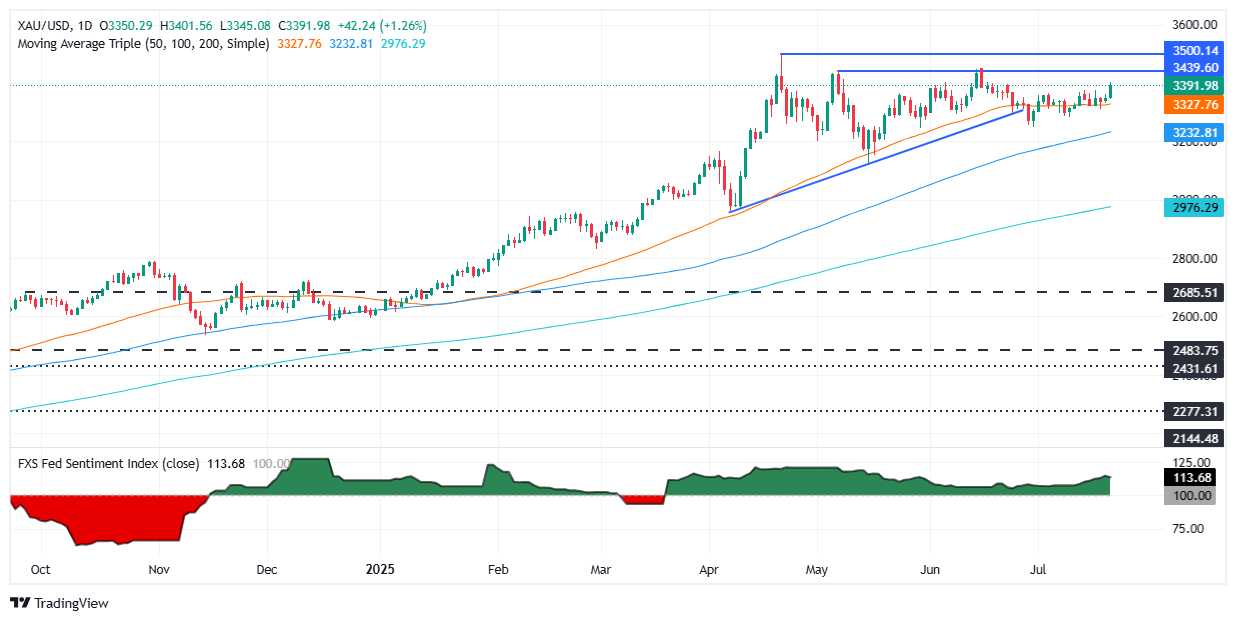Gold soars above $3,390 as US Dollar, Treasury yields slide on trade jitters, Fed independence
- Gold rises over 1% as the US Dollar Index drops below the 98.00 mark.
- Risk appetite lifts Gold as US Dollar and Treasury yields tumble on trade uncertainty.
- EU prepares retaliation plan as August 1 tariff deadline approaches.
- WSJ reports Trump advised not to fire Powell, adding pressure on Fed credibility.
Gold price rallied over 1% on Monday as the US Dollar and US Treasury yields tumbled sharply amid uncertainty over trade deals, amid an overall risk-on mood on the markets. At the time of writing, the XAU/USD trades at $3,397 after bouncing off daily lows of $3,338.
Risk appetite improved as traders await the release of earnings in the United States (US). In the meantime, the August 1 tariff deadline imposed by the White House looms, keeping investors uneasy about trade deals between the US and its three major trading partners, including the European Union (EU), Canada and Mexico.
Trade news revealed that the EU envoys are set to meet as early as this week to formalize a retaliation plan in the event of a possible no-deal scenario with US President Trump, according to Bloomberg.
The Wall Street Journal reported that US Treasury Secretary Bessent recommended Trump not to fire Fed Chair Jerome Powell, as it would cast doubts on the Federal Reserve’s (Fed) independence. This would spark a reaction in the markets, pushing the US Dollar down and US Treasury yields up.
Other news revealed that the People’s Bank of China kept its key lending rates unchanged at its latest meeting, as expected.
This week, the US economic docket remains scarce with the release of housing data, Jobless Claims for the week ending July 19, and Durable Goods Orders data.
Daily digest market movers: Gold rallies as US yields plummet
- US Treasury yields continued to drop as the 10-year Treasury note plunged over six and a half basis points (bps) to 4.356% at the time of writing. Consequently, US real yields, which are calculated by subtracting inflation expectations from the nominal interest rate, are also down six basis points at 1.946%.
- The US Dollar Index (DXY), which tracks the buck’s performance against a basket of six currencies, is down 0.64% at 97.83.
- The EU continues to work on securing a trading agreement, while also having a retaliatory backup draft aimed at targeting €72 billion worth of US exports, which would cover products such as cars, aircraft, bourbon whiskey, digital services, and other key sectors.
- Last week, US economic data remained mixed despite an improvement in Consumer Sentiment, as consumer inflation rose sharply in June, edging toward the 3% threshold. The Producer Price Index (PPI) showed signs of improvement, but a strong Retail Sales report indicates American consumers' resilience, although prices continued to climb.
- Interest rate probability indicates that the Federal Reserve will maintain its current rates, with odds standing at 97% for a hold and 3% for a 25-basis-point rate cut at the July 30 meeting.
XAU/USD technical outlook: Gold price hits $3,400 after five weeks of trading sideways
Finally, Gold has cleared the top of the $3,300-$3,350 range, reaching a five-week high of $3,401, before settling below the latter, as bullish momentum grows. The Relative Strength Index (RSI) confirms this, as the RSI edges higher toward the 60.00 level, indicating that bulls are in charge.
If XAU/USD ends the day above $3,400, expect a test of the June 16 high of $3,452, ahead of the record high of $3,500. Otherwise, if Gold stays below $3,400, the first support would be $3,350, followed by $3,300. Once cleared, prices could decline to the June 30 low of $3,246, followed by the 100-day Simple Moving Average (SMA) at $3,218.

Gold FAQs
Gold has played a key role in human’s history as it has been widely used as a store of value and medium of exchange. Currently, apart from its shine and usage for jewelry, the precious metal is widely seen as a safe-haven asset, meaning that it is considered a good investment during turbulent times. Gold is also widely seen as a hedge against inflation and against depreciating currencies as it doesn’t rely on any specific issuer or government.
Central banks are the biggest Gold holders. In their aim to support their currencies in turbulent times, central banks tend to diversify their reserves and buy Gold to improve the perceived strength of the economy and the currency. High Gold reserves can be a source of trust for a country’s solvency. Central banks added 1,136 tonnes of Gold worth around $70 billion to their reserves in 2022, according to data from the World Gold Council. This is the highest yearly purchase since records began. Central banks from emerging economies such as China, India and Turkey are quickly increasing their Gold reserves.
Gold has an inverse correlation with the US Dollar and US Treasuries, which are both major reserve and safe-haven assets. When the Dollar depreciates, Gold tends to rise, enabling investors and central banks to diversify their assets in turbulent times. Gold is also inversely correlated with risk assets. A rally in the stock market tends to weaken Gold price, while sell-offs in riskier markets tend to favor the precious metal.
The price can move due to a wide range of factors. Geopolitical instability or fears of a deep recession can quickly make Gold price escalate due to its safe-haven status. As a yield-less asset, Gold tends to rise with lower interest rates, while higher cost of money usually weighs down on the yellow metal. Still, most moves depend on how the US Dollar (USD) behaves as the asset is priced in dollars (XAU/USD). A strong Dollar tends to keep the price of Gold controlled, whereas a weaker Dollar is likely to push Gold prices up.

